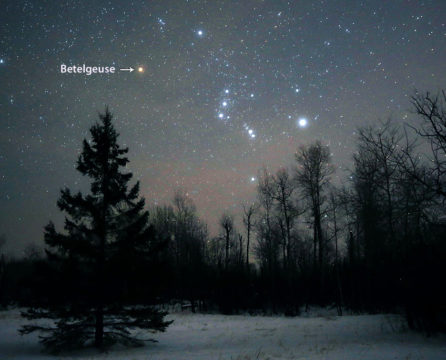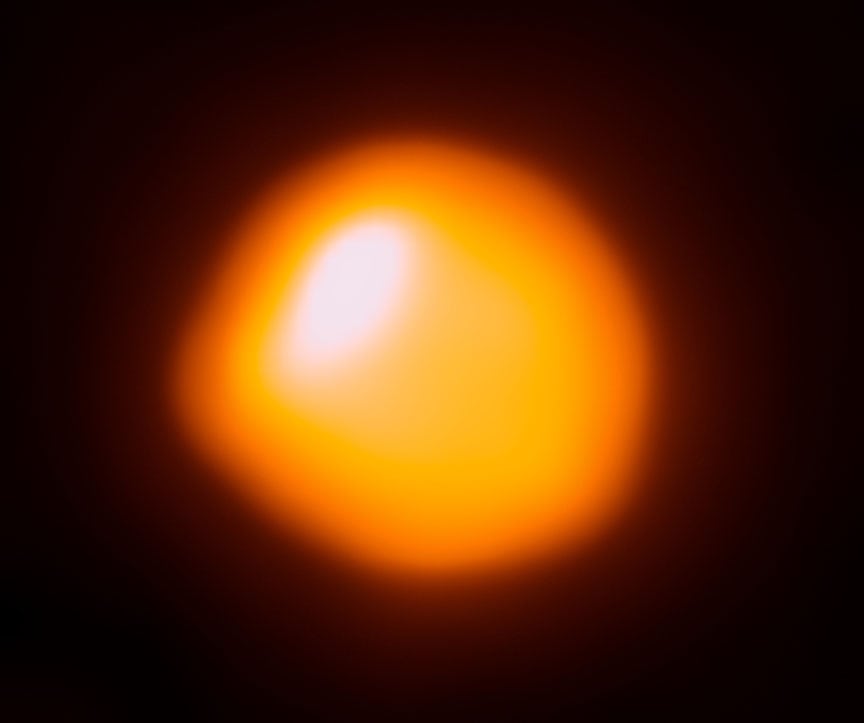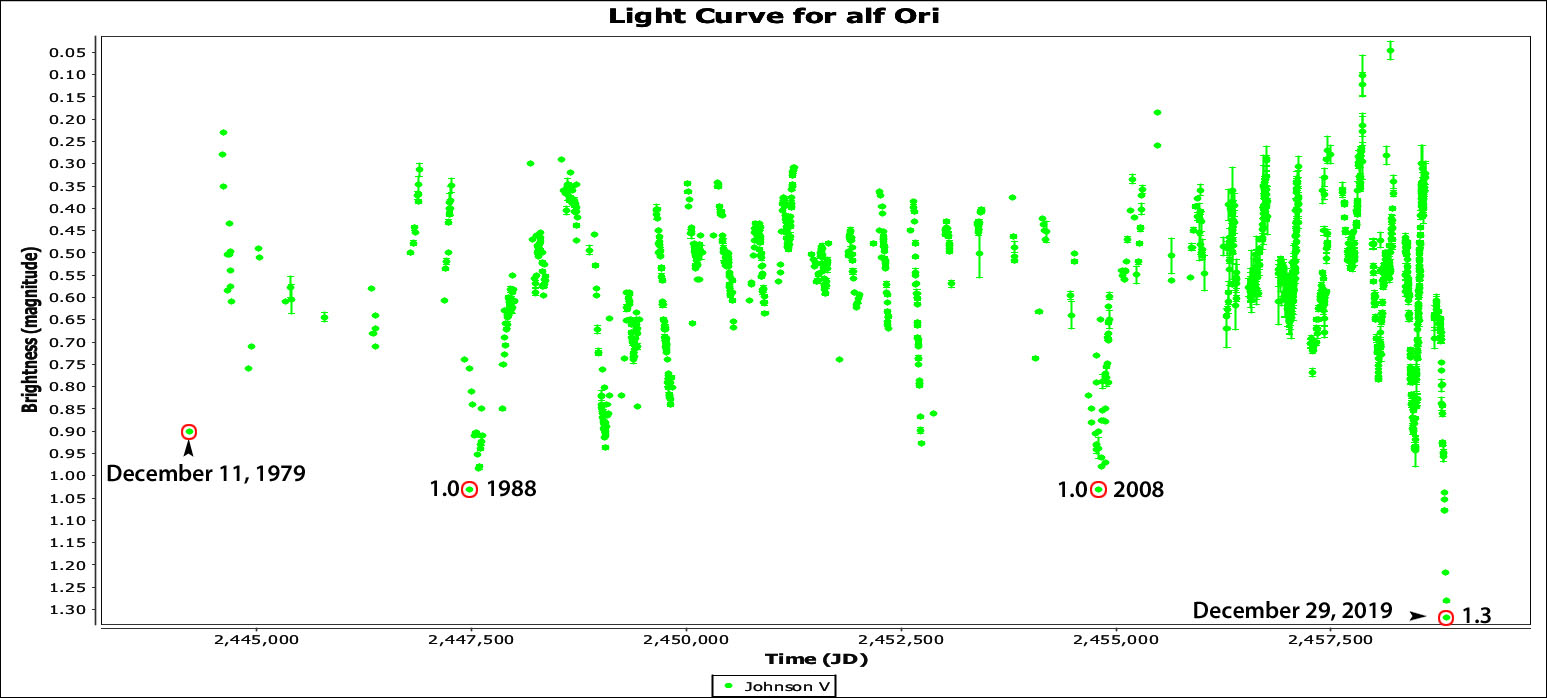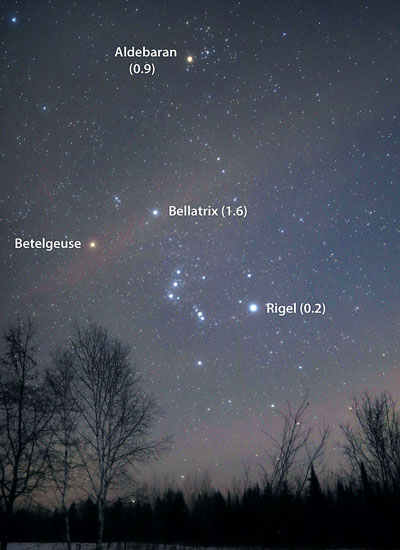The bright star Betelgeuse has faded to a historic low as astronomers try to figure out why.

Bob King
Betelgeuse, Orion's most famous star, has been in the news recently. As we wait for this supergiant to explode as a supernova, it has been doing the opposite — fading away! If you check the list of the brightest nighttime stars, Betelgeuse ranks 10th. But that’s only an average: the variable star's brightness typically varies from magnitude 0.2 (roughly like Rigel in Orion's knee) to about 1.3, only a few tenths of magnitude brighter than neighboring Bellatrix (magnitude 1.6). (Bellatrix and Rigel are also variable stars, but they vary less in brightness than Betelgeuse does.)
As recently as October, Betelgeuse glowed around magnitude 0.5, considerably brighter than its nearby Aldebaran (0.9). But observations made this month by both amateurs and professionals indicate a steep drop in brightness. On December 28.2 UT, I used Aldebaran (magnitude 0.9) and Bellatrix to estimate the star at a feeble magnitude of 1.5, nearly equal in brightness to Bellatrix. In just two months it's fallen from 10th place to 21st, according to astronomer James Kaler's 26 Brightest Stars list, a remarkable decline — and a historic low.
A Star in Trouble

ALMA (ESO / NAOJ / NRAO) / E. O’Gorman / P. Kervella
Betelgeuse is classified as a pulsating red supergiant. It physically expands and contracts as its atmosphere alternately traps and releases heat radiating from its core. When the star is smallest and hottest, it would extend to the orbit of Mars if put in place of the Sun. When largest and coolest it would balloon to span Jupiter's orbit. Although Betelgeuse is 20 times more massive than the Sun, its expanding shell has only 1/10,000 the density of air — it might be better described as a red-hot vacuum.
Betelgeuse is a semi-regular variable star with multiple periods of variation. The primary pulsations repeat every ~425 days, but the star also shows additional changes in brightness with periods of 100-180 days and 5.9 years. Dark patches that resemble monstrous sunspots as well as bright blobs of upwelling gas are behind some of these fluctuations. Betelgeuse is clearly in upheaval and will continue to surprise us before it eventually runs out of fuel, collapses, and explodes as a Type II supernova.
While the supergiant's current behavior is out of the ordinary, it doesn't necessarily mean an eruption is imminent. Astronomers predict a star-shredding blast sometime in the next 100,000 years or so.

AAVSO
Earlier this week I spoke with Sara Beck, technical assistant from the American Association of Variable Star Observers (AAVSO), about Betelgeuse. She did a quick plot of the 36,743 observations of the star in the AAVSO database starting with the first one taken on December 10, 1893. While a definitive analysis awaits, Beck agreed that the current minimum appears to be one of the faintest.
Meanwhile, astronomers Edward Guinan and Richard Wasatonic (both at Villanova University), along with amateur Thomas Calderwood, have been monitoring the star for more than 25 years. They reported a decline to magnitude 1.29 on December 20th using precise V-band photometry, making this the faintest minimum since the star was first monitored electronically in the early 20th century.
In Astronomical Telegram #13365 Guinan writes: "The current faintness of Betelgeuse appears to arise from the coincidence of the star being near the minimum light of the ~5.9-yr light-cycle as well as near the deeper than usual minimum of the ~425-d period." In effect, the star's overlapping cycles have created a sort of superminimum. Guinan encourages observers to closely monitor the star during this unusually cool and faint state.
See for Yourself

Bob King
Thankfully, nearly everyone on the planet can do this. Whether you live in the Atacama Desert or downtown New York, Betelgeuse is easy to see. Once you've found it, use Bellatrix and Aldebaran to determine its brightness to an accuracy of one-tenth of a magnitude. For instance, if Betelgeuse appears midway in brightness between Bellatrix and Aldebaran its magnitude would be about 1.3. If a little fainter or brighter one way or the other add or subtract additional tenths of a magnitude.
When making a magnitude estimate look quickly from star to star. If you stare too long, your brain will "inflate" a star's brightness. Near-sighted observers have an additional tool at their disposal. Just take off your glasses! The stars will expand into disks, making it easier to detect subtle brightness differences.
Then write that number down and return every few nights or maybe every week and make another estimate. Over time you’ll see it change right before your eyes. Betelgeuse is expected to continue fading into January and then re-brighten, but you never know what surprises may still be in store. Stars do as they please and that's half the fun.
 23
23









Comments
Jakob
January 1, 2020 at 7:49 am
If a ori erupts I have saved my glases from the great american eclipse (-: I logged Betelgeuse at mag 1,2 last night. Happy New year to you all. J
You must be logged in to post a comment.
Photon Seeker
January 6, 2020 at 6:15 am
As bright as a SN that close might be, I don't really think you'd need eclipse glasses to look at it since, unlike our much closer sun, it'll still be a starlike body (i.e a point, not a disk).
But anyone may feel free to chip in and prove me wrong on that.
Nonetheless I bet it'd - just like the full moon - still hurt the eye to look at it at night time. But I personally would still do at home what I do for observing the moon comfortably - no filters on: switch on the porch lights! This way my pupils don't get as dilated as they would in complete darkness and I can stand observing it through the eyepiece fof hours on end.
You must be logged in to post a comment.
Bob KingPost Author
January 6, 2020 at 10:52 am
Photon,
It would be a starlike point and you wouldn't need eclipse glasses. It sure would a bright point though! Half-moon or better like a super version of an Iridium satellite flare that would last much longer.
You must be logged in to post a comment.
Jim-Baughman
January 14, 2020 at 4:15 pm
I think looking at a supernova Betelgeuse through binoculars or even low power telescope magnification would be painful, just as looking at the full moon through 10x50 binoculars is. So with a strong enough light-gathering instrument, you perhaps could damage your vision peeking at such an explosion.
You must be logged in to post a comment.
Bob KingPost Author
January 6, 2020 at 11:01 am
Hi Jakob,
You won't need it. It would be OK to just look up at Betelgeuse. It would appear as a brilliant point of light.
You must be logged in to post a comment.
Stub Mandrel
January 1, 2020 at 3:08 pm
At 625 Lu away there's about a 1 in 15 chance that Betelgeuse has already gone nova.
You must be logged in to post a comment.
Corey Rueckheim
January 2, 2020 at 2:18 am
Stub, can we hear the assumptions you've made and the math you used to come up with the odds you've stated? Based on the numbers given, I think the odds you've given are too high by at least a factor of ten. The time it takes for light to travel 625 ly is only 1/160 of the 100,000 years mentioned in the article for the expected remaining lifespan of the star, and there are many more variables to consider that could easily reduce the odds even more. On the other hand, it could blow up tomorrow... we just don't have enough information to make an accurate guess.
You must be logged in to post a comment.
Stub Mandrel
January 17, 2020 at 5:15 pm
Yes you are right, for some reason I used 10,000 not 100,000 when doing my approximation.
You must be logged in to post a comment.
Bob KingPost Author
January 6, 2020 at 11:00 am
Stub,
Corey is correct. We don't know enough. Also, to be clear, Betelgeuse will not become supernova rather than a nova. Novae happen differently and involve close binary star systems. Instead, Betelgeuse will explode on its own as a supernova.
You must be logged in to post a comment.
Martian-Bachelor
January 3, 2020 at 3:03 pm
If its drop in brightness is due to a decreasing surface area then, by the natural gas law we all learned in high school chemistry, it should also be getting hotter and bluer. So the question is: do the swings in brightness in the light curve coincide with color/temperature changes?
When I heard about this on the BBC World Service Radio the other night (12/31?) we were having a clear night -- a rarity recently -- so I went out and looked. It was a) weird being so dim, and b) only a little brighter than Bellatrix, but distinctly so. I suppose that put it at 1.3 or 1.4 (+/-). It also didn't seem as colorful and red as usual but this could partly be due to its dimness.
Also, what's the difference between pulsating red super-giants like this Cepheids?
You must be logged in to post a comment.
Howard Ritter
January 4, 2020 at 8:36 am
Cepheids are a class of periodically variable stars that have evolved off the main sequence of the H-R diagram and are on their way to becoming red giants. A Type I Cepheid has a mass of only a couple of times that of the Sun. A Type II is less massive than Type I, but has also moved off the main sequence. Both types are burning helium at their cores (or are about to begin doing so), having depleted their primordial hydrogen. Both types are moving through a region of the H-R diagram known as the Cepheid instability strip.
Betelgeuse is already a red giant, one quite near the end of its evolution, ~99% of its lifetime behind it. It has more than 10 times the mass of the Sun, and has evolved far past the point of burning He, through successive eras of burning heavier and heavier elements, and is about to run out of fuel for further fission. When it does so, it will become a supernova.
Google and Wikipedia are your friends here!
You must be logged in to post a comment.
Bob KingPost Author
January 6, 2020 at 10:58 am
Hi M-B,
Yes, the swings in brightness coincide with color and temperature changes but they are not so extreme as to turn the star blue. Howard addressed the Cepheid vs. Betelgeuse difference. Betelegeuse is a supergiant at a different stage in its evolution. Its variability is far more irregular than the more clock-like Cepheids.
You must be logged in to post a comment.
max_smart_007
January 6, 2020 at 1:51 am
All this sounds great. Newbie in Vegas would appreciate your help. Looking for my first telescope. Would like to view the surrounding mountains in close detail during the day, and check out Orion at night. Thanks !
You must be logged in to post a comment.
Bob KingPost Author
January 6, 2020 at 10:51 am
Hi Max,
There are several options depending on your needs now and in the future. I highly recommend this recent Sky & Telescope post by Gary Oltion to point you to something that fits for you: https://skyandtelescope.org/astronomy-equipment/choosing-astronomy-equipment/hobby-killers-what-telescopes-not-to-buy/
If you're mostly interested in landscapes I'd get a refractor or better, a spotting scope. A spotting scope provides correct, right-side-up images. But for the night sky a 6-inch to 10-inch Dobsonian reflector would be my recommendation. So yes, get two scopes!
You must be logged in to post a comment.
Anthony Barreiro
January 6, 2020 at 3:08 pm
A spotting scope would work for both nighttime and daytime viewing. If you have a bigger budget, instead of a spotting scope I would get a 70 mm apochromatic refractor with a 90-degree star diagonal for nighttime use and a 45-degree correct-image diagonal for daytime use. Two diagonals take up less room than two telescopes. Equally importantly, get a good sturdy tripod and a mount that both moves easily and stays rock solid when you're not moving it.
You must be logged in to post a comment.
Ted-Hauter
January 13, 2020 at 12:47 am
What an amazing event...
The heart beats faster. The imagination runs wild!
To lose my favorite star... would be worth it.
Outreach to thousands now, I'd miss telling everyone it is the biggest (single) thing they can ever see, that the period at the end of this sentance would be earth compared to a 20 story sized (irregular) sphere.
You must be logged in to post a comment.
[email protected]
January 13, 2020 at 12:53 pm
Last evening (January 12), Betelgeuse appeared to my eyes as essentially the same magnitude as Belletrix (magnitude +1.6) to the right (west) of Betelgeuse.
What are others seeing? Can you recommend where to find online an updated record or graph of Betelgeuse' current brightness?
The appearance of the dimmed Betelgeuse with the rest of Orion is stunning. Rigel is so far in the lead in brightness. The reddish hue of Betelgeuse remains obvious to unaided eyes. It will be intersting to see how long this lasts.-
Peter Becker
You must be logged in to post a comment.
edibleland
January 20, 2020 at 10:11 pm
Tonight, January 20, it appears closer to Bellatrix than Aldebaran but a bit brighter so maybe it's starting to brighten; I'd say 1.4. Any other observations?
You must be logged in to post a comment.
Stub Mandrel
January 17, 2020 at 5:18 pm
On 15 January I felt Betelguese was looking closer to Alnitak (1.8) than Bellatrix (1.6) but I am not experienced in comparing star magnitudes.
Is it possible to update the light curve in the article soon with more recent data?
You must be logged in to post a comment.
Bob KingPost Author
January 21, 2020 at 11:03 am
Hi Stub,
I saw it fainter than Bellatrix last night (Jan. 20) with an estimated magnitude of 1.8. Yes, it would be possible to update the curve. I will probably do a Betelgeuse update this spring after it begins to brighten again — we hope!
You must be logged in to post a comment.
John-Lefebure
January 21, 2020 at 12:32 am
In 55 years of naked eye observation of Orion, I have never seen Betetgeuse so dim as it is tonight, a stellar performance!
You must be logged in to post a comment.
Bob KingPost Author
January 21, 2020 at 10:58 am
Hi John,
I agree! I never thought I'd report this but I estimated Betelgeuse's magnitude at 1.8 last night (Jan. 20).
You must be logged in to post a comment.
Starryeyeguy
January 21, 2020 at 12:54 pm
Using the ol' "take your glasses off" method I found Betelgeuse to be slightly dimmer that Bellatrix last night (Jan 21 @ 0300 UT) but slightly brighter than Alnitak, so I'd put it at 1.7. It's pretty amazing to see it a full magnitude fainter than its "typical" showing!
You must be logged in to post a comment.
You must be logged in to post a comment.